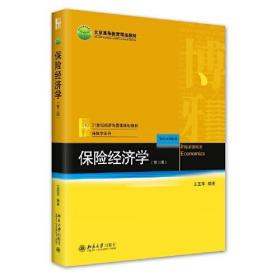
保险经济学
¥ 50.75 7.4折 ¥ 69 全新
库存5件
作者[瑞士]P.兹韦费尔、[德]R.艾森 著
出版社世界图书出版公司
出版时间2017-06
版次1
装帧平装
货号608 12-16
上书时间2024-12-16
- 在售商品 暂无
- 平均发货时间 24小时
- 好评率 暂无
- 最新上架
商品详情
- 品相描述:全新
图书标准信息
- 作者 [瑞士]P.兹韦费尔、[德]R.艾森 著
- 出版社 世界图书出版公司
- 出版时间 2017-06
- 版次 1
- ISBN 9787519220785
- 定价 69.00元
- 装帧 平装
- 开本 16开
- 纸张 胶版纸
- 页数 451页
- 【内容简介】
-
《保险经济学》全面论述了风险决策经济分析,风险管理和个体及公司的保险需求,目标追踪和保险公司用的管理工具,保险监管,以及个人保险和社会保险之间的分工。本书是一部教科书,书中提供了理解本书内容所必需的背景知识。各章有习题,适用于经济、管理和金融专业的高年级本科生和低年级研究生。
- 【作者简介】
-
兹韦费尔(Peter Zweifel,瑞士)和艾森(Roland Eisen,德国)是金融保险领域的知名学者,《保险经济学》是为大学高年级本科生和低年级研究生教材.
- 【目录】
-
Introduction: Insurance and Its Economic Role
1.1 Basics and Definitions
1.2 Risks and Their Development Over Time
1.3 Macroeconomic Importance of Insurance
1.4 Functions of Insurance
1.5 Major Determinants of the Demand for Insurance
1.5.1 The Effects of Wealth and Income
1.5.2 The Effect of Price
1.6 System Analysis and Organization of the Book
1.E Exercises
Risk: Measurement Perception,and Management
2.1 Definition and Measurement of Risk
2.1.1 Definition of Risk
2.1.2 Measurement of Risk
2.2 Subjective Perception of Risk,Risk Aversion,and the Risk Utility Function
2.2.1 Risk Perception as a Subjective and Cultural Phenomenon
2.2.2 Risk Aversion and the Risk Utility Function
2.3 Willingness to Pay for Certainty,Risk Aversion,and Prudence
2.3.1 Willingness to Pay for Certainty,Certainty Equivalent,and Risk Premium
2.3.2 Risk Premium and Coefficients of Risk Aversion
2.3.3 Prudence and Higher-Order Derivatives of the Risk Utility Function
2.4 Estimates of Risk Aversion
2.4.1 Microeconoraie Evidence
2.4.2 Macroeconomic Evidence
2.5 Instruments of Risk Management
2.6 Effectiveness of Risk Management and Risk Policy Measures
2.A Appendix: Stochastic Dominance
2.A.1 First-Degree Stochastic Dominance
2.A.2 Second-Degree Stochastic Dominance
2.E Exercises
3 Insurance Demand I: Decisions Under Risk Without Diversification Possibilities
3.1 The Expected Utility Maximization Hypothesis
3.2 Theory of Insurance Demand
3.2.1 The Basic Model
3.2.2 Insurance Demand in the Presence of Irreplaceable Assets
3.3 Demand for Insurance Without Fair Premiums
3.3.1 Optimal Degree of Coverage Without Fair Premiums.
3.3.2 Risk Aversion as a Determinant of Insurance Demand
3.3.3 Premium Rate and Wealth as Determinants of Insurance Demand
3.3.4 Pareto-Optimal Insurance Contracts
3.4 Demand for Insurance with Multiple Risks
3.5 Relation Between Insurance Demand and Prevention
3.6 Critique of the Expected Utility Hypothesis and Alternatives
3.6.1 Anomalies of Expected Utility Theory
3.6.2 Alternatives to Expected Utility Theory
3.E Exercises
4 Insurance Demand Ⅱ: Decisions Under Risk with Diversification Possibilities
4.1 Risk Management and Diversification
4.1.1 Risk Management and Internal Diversification
4.1.2 Risk Diversification Through the Capital Market
4.1.3 The Capital Asset Pricing Model(CAPM)
4.1.4 Arbitrage Pricing Theory(APT)
4.2 Risk Management,Forward Contracts,Futures,and Options
4.2.1 Hedging Through Forward Contracts and Options
4.2.2 Hedging Through Stock Options
4.3 Corporate Demand for Insurance
4.3.1 Demand for Insurance in the Light of Capital Market Theory
4.3.2 Empirical Studies of Corporate Demand for Insurance
4.3.3 Reasons for Corporate Demand for Insurance Not Related to the Capital Market
4.E Exercises
5 The Insurance Company and Its Insurance Technology
5.1 Financial Statements of an Insurance Company
5.1.1 The Balance Sheet
5.1.2 Operational Statement
5.2 Objectives of the IC
5.2.1 Theoretical Considerations
5.2.2 Empirical Evidence Concerning the Importance of IC Objectives
5.3 Survey of Insurance Technology of an IC
5.3.1 What is the Output of an IC?
5.3.2 Instruments of Insurance Technology
5.4 Choice of Distribution Channel
5.4.1 Main Distribution Channels for Insurance Products
5.4.2 The Principal-Agent Relationship as the Underlying Problem
5.4.3 A Comparison of Cost of Distribution Channels Using U.S.Data
5.4.4 A Study Relating Performance to Incentives
5.5 Underwriting Policy
5.5.1 Instruments of Underwriting Policy
5.5.2 A Simple Model of Risk Selection
5.6 Controlling Moral Hazard Effects
5.7 Reinsurance
5.7.1 Functions of Reinsurance
5.7.2 Types of Reinsurance
5.7.3 A Model of Demand for Reinsurance Based on Option Pricing Theory
5.7.4 Empirical Testing of the Model
5.8 Capital Investment Policy
5.E Exercises
6 The Supply of Insurance
6.1 Traditional Premium Calculation
6.1.1 Claims Process and Loss Distribution
6.1.2 Basics of Probability Theory and Insurer's Risk
6.1.3 Premium Principles
6.2 Financial Models of Insurance Pricing
6.2.1 Portfolio Optimization by the IC
6.2.2 Pricing According to Insurance CAPM
6.2.3 Pricing According to Option Pricing Theory
6.2.4 Empirical Evidence on the Actual Behavior of IC
6.3 Economies of Scope
6.3.1 Economies of Scope and Properties of the Cost Function
6.3.2 Empirical Relevance of Economies of Scope
6.3.3 Stochastic Economies of Scope
6.4 Economies of Scale
6.4.1 Definitional Issues
6.4.2 Empirical Relevance of Economies of Scale in Life Insurance
6.4.3 Empirical Relevance of Economies of Scale in Non-life Insurance
6.4.4 Alternatives and Extensions
6.4.5 Scale Economies and Size of Market
6.E Exercises
Insurance Markets and Asymmetric Information
7.1 Asymmetric Information and Its Consequences
7.2 Moral Hazard
7.2.1 Definition and Importance of Moral Hazard
7.2.2 Ex-Ante Moral Hazard
7.2.3 Market Equilibrium with Ex-Ante Moral Hazard
7.2.4 Empirical Evidence on Ex-Ante Moral Hazard
7.2.5 Ex-Post Moral Hazard in Short-Term Disability Insurance
7.3 Adverse Selection
7.3.1 Adverse Selection in a Single-Period Framework
7.3 ,2 Empirical Relevance of Adverse Selection
7.3.3 Adverse Selection in a Multi-Period Context
7.3.4 Empirical Evidence Regarding the Experience-Rating Model
7.4 Adverse Selection and Moral Hazard in Combination
7.E Exercises
Regulation of Insuranee
8.I Objectives and Types of Insurance Regulation
8.1.1 Objectives of Insurance Regulation
8.1.2 Avoidance of Negative Externalities
8.1.3 Material Regulation
8.1.4 Regulation Limited to Formal Requirements
8.1.5 Historical Differences in Insurance Regulation Between Countries
8.2 Three Competing Theories of Regulation
8.2.1 Public Interest Theory
8.2.2 Capture Theory
8.2.3 Market for Regulation Theory
8.2.4 Empirically Testable Implications for Insurance
8.3 Effects of Insurance Regulation
8.3.1 Evidence from the United States
8.3.2 Risk-Based Capital as the U.S.Regulatory Response
8.3.3 Evidence from Europe
8.4 Recent Trends in Insurance Regulation
8.4.1 The Financial Crisis of 2007-2009
8.4.2 The Convergence of Banking and Insurance and Regulation
8.4.3 Systemic Risk in Insurance Markets?
8.4.4 Characterization of Recent Regulatory Initiatives
8.E Exercises
9 Social Insurance
9.1 Importance of Social Insurance
9.2 Why Social Insurance?
9.2.1 Social Insurance as an Efficiency-Enhancing Institution
9.2.2 Social Insurance as an Instrument Wielded by Political Decision Makers
9.3 Overview of the Branches of Social Insurance
9.3.1 Structural Characteristics of Social Insurance
9.3.2 Importance of Branches of Social Insurance
9.4 Requirements for Etficient Social Insurance
9.4.1 Comparing the Efficiency of Provision for Old Age
9.4.2 Efficiency Assessment from a Portfolio Theory Perspective
9.5 Macroeconomic Impacts of Social Insurance
9.5 ,1 Impacts of Provision for Old Age
9.5.2 Impacts of Social Health Insurance
9.5.3 Impacts of Unemployment Insurance
9.5.4 Optimal Amount of Social Insurance
9.E Exercises
10 Challenges Confronting Insurance
10.1 Globalization of International Economic Relations
10.1.1 Glohalizatioa and Corporate Insurance
10.1.2 Globalization and Individual Insurance
10.2 Changes in Science and Technology
10.2.1 Genetic Information
10.2.2 Advances in Information Technology
10.3 Changes in Legal Norms
10.3.1 Principal Elements of Insurance Contract Law
10.3.2 Consequences of Deregulation
10.4 Increased Frequency and Severity of Catastrophic Events
10.4.1 New Elements of Insurance Technology
10.4.2 Issues Linked to Reinsurance of Catastrophic Risks
10.4.3 Alternative Risk Transfer Through Capital Markets
10.5 Demographic Change
10.5.1 Aging of Population
10.5.2 Increasing Share of One-Person Households
10.6 Final Remarks
References
Author Index
Subject Index
相关推荐
— 没有更多了 —
















以下为对购买帮助不大的评价